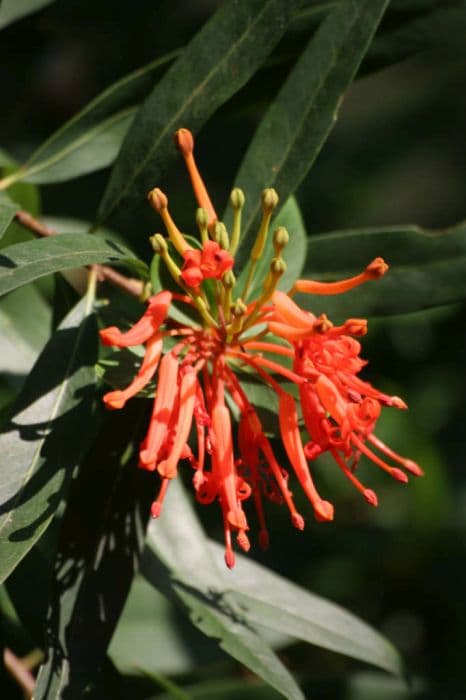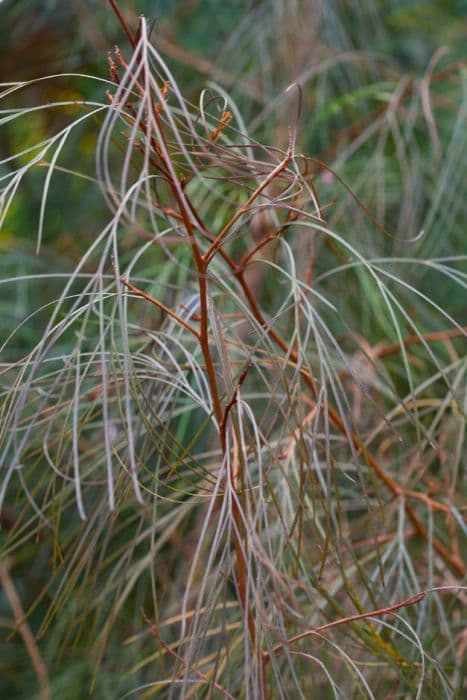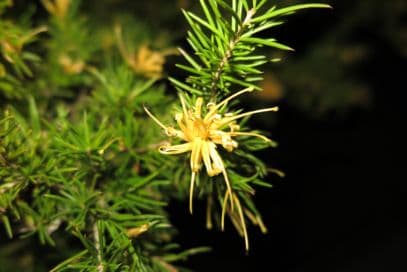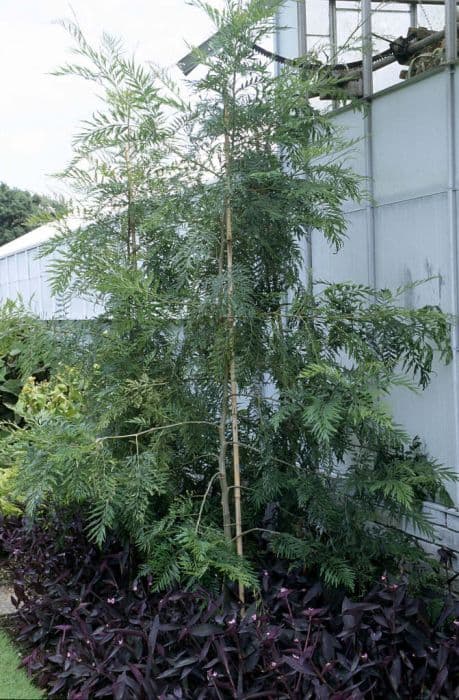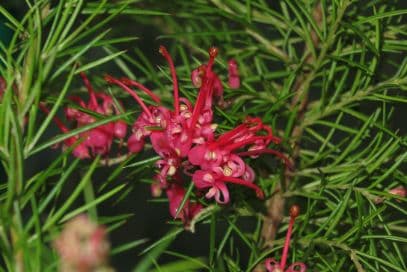Chilean Fire Bush Embothrium coccineum (Lanceolatum Group) 'Inca Flame'

ABOUT
The 'Inca Flame' variety of the Chilean Fire Tree has a stunning and vibrant appearance that captures the essence of its common name. This plant is notable for its brilliant display of fiery red, tubular flowers that come into bloom, creating a spectacular show. These flowers are arranged in dense clusters at the ends of the branches, which adds a splash of intense color that is highly attractive to hummingbirds and other pollinators. The foliage of the 'Inca Flame' is equally attractive, with narrow, lance-shaped leaves that maintain a rich green color throughout the growing season. These leaves are arranged alternately along the branches, providing a lush backdrop for the dramatic floral display. The leaves may also take on a reddish tinge as they mature which complements the red flowers. The bark of the 'Inca Flame' Chilean Fire Tree adds to its ornamental value with a smooth texture and a color that may vary from a grayish-brown to a more reddish-brown hue, depending on the maturity of the plant. The overall form of the tree is often upright and slightly spreading, giving it an elegant and graceful presence in the landscape. This plant is loved not only for its visual appeal but also for its ability to bring a touch of exotic warmth to gardens with its bright, fiery colors.
About this plant
 Names
NamesFamily
Proteaceae.
Synonyms
Chilean Firebush, Chilean Flame Flower, Fire Bush.
Common names
Embothrium coccineum var. lanceolatum, Embothrium lanceolatum.
 Toxicity
ToxicityTo humans
The common name for Embothrium coccineum (Lanceolatum Group) 'Inca Flame' is Chilean firebush. There is limited information on the toxicity of Chilean firebush to humans. However, most sources do not report it as a commonly toxic plant to humans. In the absence of specific data, it is always a good practice to avoid ingesting parts of ornamental plants due to potential unknown toxins. If a plant is not specifically known to be edible, it may have the potential to cause symptoms such as gastrointestinal upset if ingested. If you suspect poisoning from any plant, seek medical attention.
To pets
The common name for Embothrium coccineum (Lanceolatum Group) 'Inca Flame' is Chilean firebush. As with human toxicity, there is limited specific information regarding its toxicity to pets. It is not commonly listed as a toxic plant for pets. Even though it may not be classified as toxic, it is generally recommended to prevent pets from ingesting plants that are not known to be safe. If a pet ingests parts of Chilean firebush or any unknown plant, watch for signs of illness such as vomiting, diarrhea, or unusual behavior and contact your veterinarian for advice.
 Characteristics
CharacteristicsLife cycle
Perennials
Foliage type
Evergreen
Color of leaves
Green
Flower color
Red
Height
20 feet (6 meters)
Spread
10 feet (3 meters)
Plant type
Tree
Hardiness zones
9
Native area
Chile
Benefits
 General Benefits
General Benefits- Ornamental Value: The 'Inca Flame' variety of Embothrium coccineum, commonly known as Chilean Firebush, is highly appreciated for its striking red flowers that add significant ornamental appeal to gardens and landscapes.
- Attracts Wildlife: The bright blossoms attract pollinators such as bees and hummingbirds, promoting biodiversity in the garden ecosystem.
- Seasonal Interest: With its vibrant flowers blooming in the spring, Chilean Firebush provides a burst of color early in the gardening season when other plants may not yet be in bloom.
- Low Maintenance: Once established, this plant is relatively low maintenance, requiring minimal care beyond occasional watering and pruning.
- Drought Tolerance: Chilean Firebush is known for its ability to withstand periods of drought, making it suitable for xeriscaping or gardens with low water availability.
- Fast Growing: It is a fast-growing plant, quickly establishing itself and providing landscape coverage and decoration.
 Medical Properties
Medical PropertiesThis plant is not used for medical purposes.
 Air-purifying Qualities
Air-purifying QualitiesThis plant is not specifically known for air purifying qualities.
 Other Uses
Other Uses- Chilean Firetree's dried flowers can be used to create natural confetti for eco-friendly celebrations or crafting.
- Its vibrant flowers are an excellent source for natural dyes, often used in textile coloring.
- The wood of Chilean Firetree is sometimes utilized in fine woodworking or for creating small decorative items.
- The tree's unique shape and foliage can act as a windbreak in coastal areas prone to strong winds.
- When planted in groups, Chilean Firetree can serve as a natural privacy screen and noise barrier.
- Landscape artists use the striking appearance of the Chilean Firetree for focal points in garden designs.
- The nectar-rich flowers are used in gardens to attract and support populations of pollinators like hummingbirds and bees.
- Leaves of the Chilean Firetree may be used in educational settings for botanical studies due to their distinctive characteristics.
- The tree is occasionally grown for festive decoration during times of flowering, especially in South American celebrations.
- Branches and flowers can be incorporated into floral arrangements and bouquets for a touch of exuberant color.
Interesting Facts
 Feng Shui
Feng ShuiThe Chilean fire bush is not used in Feng Shui practice.
 Zodiac Sign Compitability
Zodiac Sign CompitabilityThe Chilean fire bush is not used in astrology practice.
 Plant Symbolism
Plant Symbolism- Passion: Known commonly as the Chilean fire bush, the 'Inca Flame' variety of Embothrium coccineum presents brilliant red flowers, evocative of flames and ardor, symbolizing intense feelings and emotion.
- Enthusiasm: The fiery appearance of its blooms suggests exuberance and a zest for life, embodying an enthusiastic spirit.
- Transformation: The striking red flowers that emerge from the green foliage signify change and the idea of rebirth, much like fire can clear old growth to make way for the new.
- Attraction: The vivid color of the Chilean fire bush can symbolize attraction and magnetism, illustrating a powerful and irresistible allure.
 Water
WaterThe Chilean fire tree should be watered deeply but infrequently, allowing the soil to dry out somewhat between waterings. Typically, watering once a week with approximately 1 to 2 gallons of water should be sufficient, but this may vary based on climate and soil conditions. During hot, dry periods, water needs may increase, and the tree may benefit from an additional watering. Reduce watering in the fall and winter when the plant is dormant. Ensure adequate drainage to prevent waterlogging, which can lead to root rot.
 Light
LightThe Chilean fire tree thrives in full sun to partial shade. It performs best when it receives at least six hours of direct sunlight per day. A spot that provides morning sunlight followed by dappled afternoon shade can help protect the tree from the intense heat of late day sun, particularly in hotter climates.
 Temperature
TemperatureThe Chilean fire tree can tolerate a range of temperatures but prefers a temperate climate. It can survive minimum temperatures down to approximately 20°F but may sustain damage or die back in colder conditions. The ideal growing temperatures are between 60°F and 75°F. These trees are not suited for extreme heat or cold and should be planted in locations where temperatures remain within their tolerance range.
 Pruning
PruningThe Chilean fire tree should be pruned to maintain its shape and remove any dead or diseased branches. Pruning is best carried out in late winter or early spring before new growth begins. It is not necessary to prune every year, but a general thinning every few years will help maintain airflow and light penetration within the canopy, promoting overall health and more vibrant flowering.
 Cleaning
CleaningAs needed
 Soil
SoilThe Chilean Fire Bush 'Inca Flame' prefers well-draining, acidic to neutral soil with a pH between 5.5 and 7.0. A mix containing peat, coarse sand, and loamy soil often works well for this plant, ensuring good drainage and aeration which is crucial for its roots.
 Repotting
RepottingChilean Fire Bush 'Inca Flame' should be repotted every 2 to 3 years. Younger plants may require more frequent repotting as they grow, but mature plants can be repotted less often as their growth rate slows.
 Humidity & Misting
Humidity & MistingThe Chilean Fire Bush 'Inca Flame' thrives in moderate to high humidity levels. Aim for humidity levels between 40% and 70% to provide the best environment for this plant.
 Suitable locations
Suitable locationsIndoor
Use bright, indirect light and acidic soil mix.
Outdoor
Plant in acidic soil, ensure full sun exposure.
Hardiness zone
8-10 USDA
 Life cycle
Life cycleThe Chilean Fire Bush 'Inca Flame' begins its life cycle as a seed, often requiring pre-treatment to break dormancy before germination can occur. Upon germination, the seed develops into a seedling with a set of true leaves, distinct from the cotyledons (seed leaves), and begins to establish a root system. As it enters the vegetative stage, 'Inca Flame' exhibits rapid growth, forming a shrub-like structure with lance-shaped, glossy green leaves. It then progresses to the reproductive stage, producing striking clusters of tubular, red or orange flowers that attract pollinators such as hummingbirds. After pollination, it sets fruit that matures into a dehiscent capsule, releasing seeds to complete the cycle. During its lifespan, 'Inca Flame' may also undergo vegetative propagation, wherein cuttings taken from a mature plant can root and grow into a genetically identical individual.
 Propogation
PropogationPropogation time
Spring-Early Summer
The Chilean firetree, known as Embothrium coccineum 'Inca Flame', is often propagated during its dormant season, typically in late winter to early spring. The most popular method of propagation for this plant is to use semi-hardwood cuttings taken in summer. To propagate from cuttings, one would select a healthy, non-flowering branch and take a cutting about 4 to 6 inches (10 to 15 cm) long, making sure to include several leaf nodes. The cut end can be dipped in a rooting hormone to increase the chances of successful root development. The cutting should then be placed in a well-draining potting mix, kept moist, and ideally placed in a warm spot with indirect light until roots have developed and the plant can be transitioned to its permanent location.
